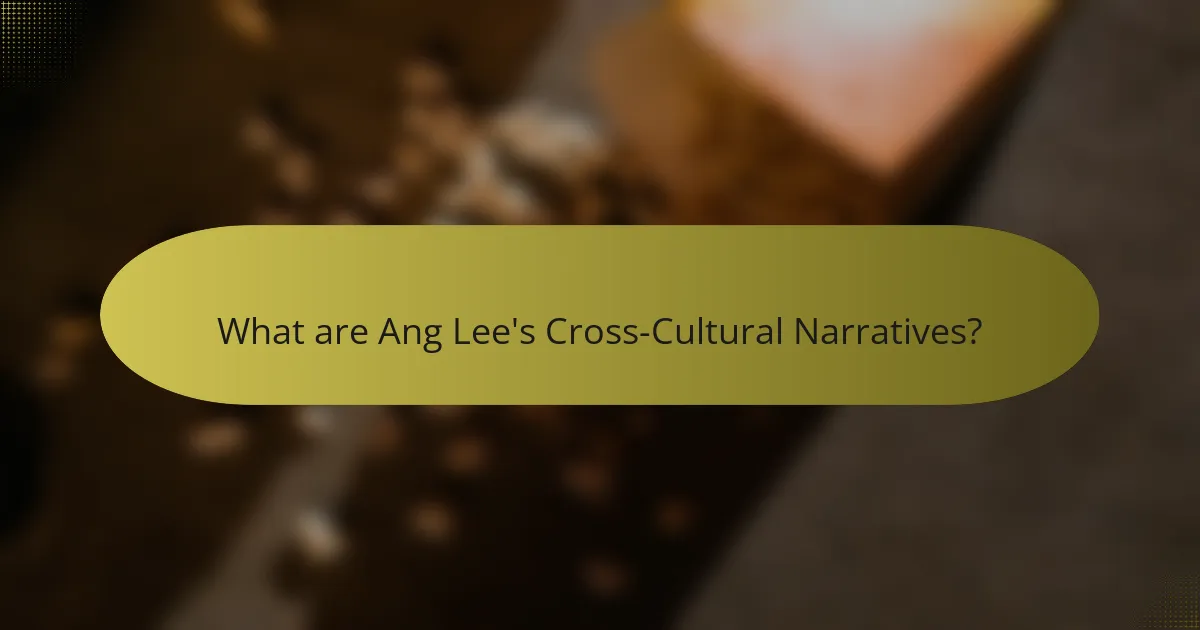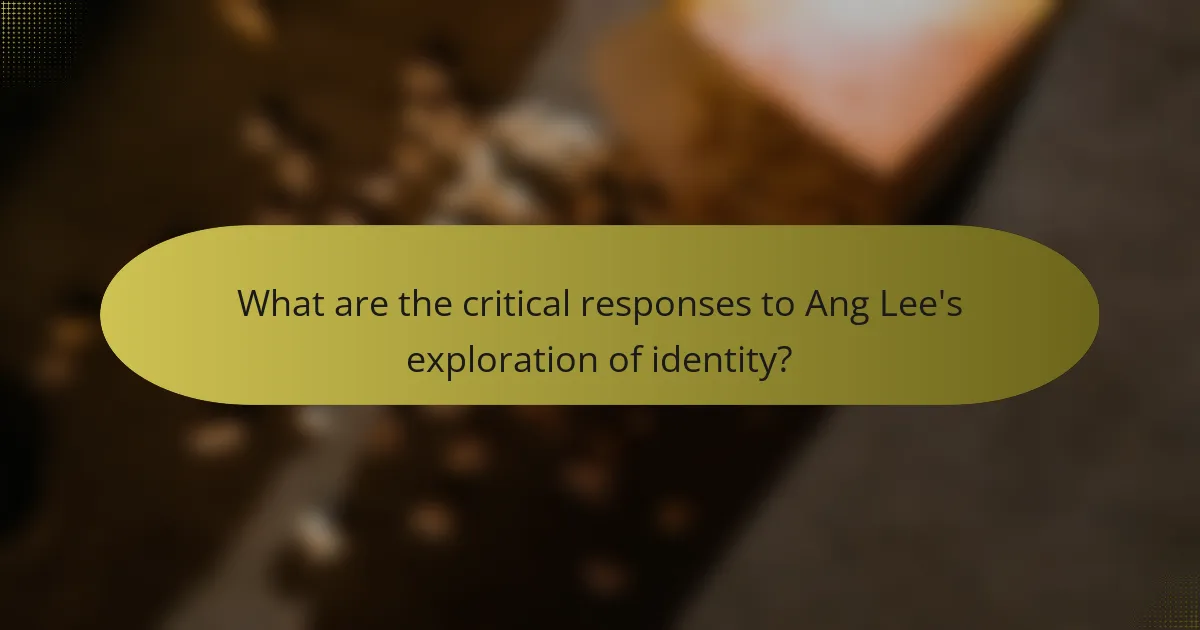Ang Lee is a filmmaker known for his cross-cultural narratives that explore themes of identity, belonging, and cultural clashes. His films, such as “The Joy Luck Club,” “Crouching Tiger, Hidden Dragon,” and “The Wedding Banquet,” depict characters grappling with cultural duality and the emotional struggles that arise from differing cultural expectations. Lee employs various storytelling techniques, including non-linear narratives and genre blending, to deepen the audience’s understanding of these themes. Critical responses to his work highlight the complexity of his portrayals of cultural identity, acknowledging both his sensitivity and the potential for stereotype reinforcement. Overall, Lee’s films significantly contribute to the discourse on cross-cultural identity in cinema.

What are Ang Lee’s Cross-Cultural Narratives?
Ang Lee’s cross-cultural narratives explore themes of identity, belonging, and the clash of cultures. His films often depict characters navigating the complexities of cultural duality. For example, “The Joy Luck Club” illustrates the generational divide between Chinese immigrant mothers and their American-born daughters. “Crouching Tiger, Hidden Dragon” blends Eastern and Western storytelling elements, showcasing universal themes of love and honor. Lee’s work frequently highlights the emotional struggles of individuals caught between different cultural expectations. His narratives resonate with diverse audiences, reflecting shared human experiences. Lee’s films have received critical acclaim, reinforcing their significance in the discourse on cross-cultural identity.
How do Ang Lee’s films reflect cultural diversity?
Ang Lee’s films reflect cultural diversity through their exploration of varied cultural identities and experiences. His works often depict the complexities of navigating multiple cultures. For instance, “The Wedding Banquet” highlights the clash between traditional Chinese values and Western lifestyles. In “Crouching Tiger, Hidden Dragon,” Lee showcases a blend of Eastern philosophy and Western storytelling techniques. His film “Life of Pi” presents a multicultural narrative that incorporates elements from different religions and backgrounds. Lee’s characters frequently grapple with issues of belonging and identity. This portrayal resonates with audiences across cultures. His films have received international acclaim, emphasizing their universal themes. Lee’s ability to weave diverse cultural narratives is a hallmark of his filmmaking style.
What themes are prevalent in Ang Lee’s cross-cultural narratives?
Ang Lee’s cross-cultural narratives often explore themes of identity, belonging, and cultural conflict. His films frequently depict the struggle between traditional values and modern influences. This theme is evident in works like “The Wedding Banquet,” which addresses the clash of cultural expectations in a multicultural setting. Another prevalent theme is the exploration of familial relationships and their complexities across different cultures. “Pushing Hands” illustrates generational divides and the challenges of adapting to new environments. Additionally, Lee’s narratives often highlight the fluidity of identity amid changing cultural landscapes. This is particularly seen in “Brokeback Mountain,” where personal identity intersects with societal norms. Overall, Ang Lee’s films provide a nuanced examination of how individuals navigate their identities within diverse cultural contexts.
How does Ang Lee portray the interaction between different cultures?
Ang Lee portrays the interaction between different cultures by highlighting the complexities of identity and belonging. He often uses characters caught between contrasting cultural backgrounds. In films like “The Wedding Banquet,” Lee explores the clash between traditional Chinese values and modern Western ideals. This film showcases the challenges of cultural assimilation and familial expectations. In “Brokeback Mountain,” he examines the intersection of American culture and personal identity. Lee’s storytelling emphasizes emotional connections across cultural divides. His visual style often contrasts settings to symbolize cultural differences. Through nuanced character development, he illustrates the struggle for acceptance in a multicultural world.
Why is identity exploration significant in Ang Lee’s work?
Identity exploration is significant in Ang Lee’s work because it reflects the complexities of cultural and personal identity. Lee’s films often depict characters grappling with their cultural backgrounds and personal beliefs. This theme resonates in works like “The Wedding Banquet” and “Brokeback Mountain.” In “The Wedding Banquet,” the clash between traditional Chinese values and modern American life highlights the struggle of identity. “Brokeback Mountain” explores the conflict between societal expectations and personal truth. Lee’s storytelling emphasizes the fluidity of identity in a globalized world. His narratives challenge viewers to reconsider preconceived notions of identity. This exploration fosters empathy and understanding across diverse cultures.
How do characters in Ang Lee’s films navigate their identities?
Characters in Ang Lee’s films navigate their identities through cultural conflict and personal struggle. They often face the tension between traditional values and modern influences. This duality is evident in films like “The Wedding Banquet” and “Brokeback Mountain.” In “The Wedding Banquet,” the protagonist grapples with familial expectations and his [censured] orientation. “Brokeback Mountain” explores the internal conflict of love against societal norms. Ang Lee’s characters frequently experience isolation and longing for acceptance. Their journeys reflect broader themes of identity, belonging, and the search for self. Lee’s storytelling highlights the emotional depth of these struggles, resonating with diverse audiences.
What role does personal background play in shaping identity in his narratives?
Personal background significantly influences identity in Ang Lee’s narratives. His Taiwanese upbringing shapes his storytelling and character development. Lee often explores themes of cultural conflict and belonging. His experiences in both Eastern and Western cultures provide a unique perspective. This duality creates complex characters grappling with their identities. For instance, in “The Wedding Banquet,” characters navigate cultural expectations and personal desires. Lee’s narratives reflect his own struggles with identity, illustrating the impact of personal history. Overall, his background enriches the exploration of identity in his films.

How does Ang Lee use storytelling techniques in his films?
Ang Lee uses storytelling techniques to explore complex themes of identity and culture. He often employs non-linear narratives to enhance emotional depth. This technique allows viewers to experience characters’ internal conflicts more vividly. Lee’s films frequently blend genres, creating unique storytelling experiences. For instance, “Crouching Tiger, Hidden Dragon” combines martial arts with romance and philosophy. He also utilizes rich visual imagery to convey emotional states. The cinematography in “Life of Pi” illustrates the protagonist’s spiritual journey through stunning visuals. Additionally, Lee incorporates cultural elements to highlight cross-cultural tensions. His adaptation of “The Wedding Banquet” showcases the clash between traditional and modern values. These techniques collectively deepen the audience’s understanding of the characters’ struggles.
What narrative styles does Ang Lee employ to convey cross-cultural themes?
Ang Lee employs a variety of narrative styles to convey cross-cultural themes. He often utilizes non-linear storytelling to reflect the complexities of identity. This technique allows for multiple perspectives and cultural contexts to emerge. Lee also incorporates rich visual symbolism to enhance emotional depth. His films frequently blend genres, merging elements of drama, romance, and action. This genre fusion helps to bridge cultural divides. Additionally, he employs intimate character development to explore personal and cultural conflicts. His narrative styles effectively illustrate the nuances of cross-cultural experiences. Examples include “The Wedding Banquet” and “Crouching Tiger, Hidden Dragon,” which showcase these techniques.
How does the use of flashbacks enhance identity exploration in his films?
The use of flashbacks in Ang Lee’s films enhances identity exploration by providing insight into characters’ pasts. Flashbacks reveal formative experiences that shape their present identities. This technique allows viewers to understand the emotional and cultural contexts influencing characters. In films like “The Wedding Banquet,” flashbacks illustrate the clash between traditional values and modern identity. They highlight internal conflicts faced by characters navigating different cultural expectations. By juxtaposing past and present, flashbacks deepen the audience’s connection to the characters’ struggles. This narrative device effectively portrays the complexity of identity in cross-cultural settings.
What impact do visual elements have on storytelling in Ang Lee’s narratives?
Visual elements significantly enhance storytelling in Ang Lee’s narratives. They create emotional depth and establish cultural context. Lee utilizes color, composition, and cinematography to evoke feelings. For example, the lush landscapes in “Life of Pi” symbolize the protagonist’s inner journey. In “Crouching Tiger, Hidden Dragon,” visual choreography complements themes of freedom and restraint. The interplay between visuals and narrative structure enriches character development. Lee’s use of visual metaphors often reflects complex identities. These elements engage viewers, making the storytelling more immersive and impactful.
How does Ang Lee’s background influence his storytelling?
Ang Lee’s background significantly influences his storytelling by shaping his exploration of cultural identity. Born in Taiwan and later moving to the United States, Lee experiences both Eastern and Western cultures. This duality informs his narratives, allowing him to create stories that resonate across cultural boundaries. His films often address themes of family, tradition, and the immigrant experience. For instance, “The Joy Luck Club” and “Crouching Tiger, Hidden Dragon” reflect his ability to blend cultural elements. Lee’s diverse background enables him to portray complex characters grappling with identity. His films invite audiences to engage with universal themes through a cross-cultural lens.
What aspects of Ang Lee’s personal experiences shape his films?
Ang Lee’s films are significantly shaped by his personal experiences as a Taiwanese immigrant. His upbringing in Taiwan and subsequent move to the United States inform his exploration of cultural identity. Lee often portrays the clash between Eastern and Western values in his narratives. His experiences of cultural displacement are evident in films like “The Wedding Banquet.” This film reflects his understanding of the complexities of identity in a multicultural context. Additionally, Lee’s family background influences themes of familial relationships and expectations. His diverse experiences allow him to create authentic cross-cultural narratives. This blend of personal history and cultural insight enriches his storytelling.
How does his cultural heritage inform his approach to identity?
Ang Lee’s cultural heritage significantly informs his approach to identity. He draws from his Taiwanese upbringing and Chinese cultural roots. These influences shape his exploration of themes like duality and belonging. Lee often contrasts Eastern and Western perspectives in his films. This interplay highlights the complexities of identity in a globalized world. For example, in “The Wedding Banquet,” he addresses cultural expectations and personal desires. His narratives reflect the struggles of individuals navigating multiple cultural identities. This approach resonates with audiences facing similar experiences. Lee’s heritage thus serves as a foundational element in his storytelling.

What are the critical responses to Ang Lee’s exploration of identity?
Ang Lee’s exploration of identity has received diverse critical responses. Critics often highlight the complexity and nuance in his portrayal of cultural identity. Many praise his ability to navigate cross-cultural themes with sensitivity and depth. For instance, films like “The Wedding Banquet” and “Brokeback Mountain” showcase the struggles of characters caught between different cultural expectations. Some critics argue that his works challenge traditional notions of identity. Others contend that his narratives sometimes fall into stereotypes. Overall, responses reflect a recognition of Lee’s impact on discussions of identity in cinema.
How have audiences reacted to the themes of identity in his films?
Audiences have reacted positively to the themes of identity in Ang Lee’s films. Viewers often resonate with his exploration of cultural and personal identity. His films, such as “The Wedding Banquet” and “Brokeback Mountain,” highlight the complexities of identity in diverse contexts. Many audience members appreciate the emotional depth and authenticity in his characters. Critical acclaim often emphasizes how Lee’s storytelling bridges cultural divides. Audience reviews frequently mention the relatability of his characters’ struggles with identity. This connection fosters a deeper understanding of cross-cultural experiences. Overall, audiences find Lee’s treatment of identity both impactful and thought-provoking.
What criticisms have been leveled against Ang Lee’s portrayal of cultural identity?
Critics have argued that Ang Lee’s portrayal of cultural identity often lacks authenticity. Some feel that his films oversimplify complex cultural issues. For instance, “The Joy Luck Club” faced backlash for its portrayal of Asian-American experiences. Critics claimed it reinforced stereotypes rather than providing depth. Additionally, Lee’s approach in “Life of Pi” was seen as a Western interpretation of Eastern [censured]. This perspective raised concerns about cultural appropriation. Furthermore, some audiences believe his narratives prioritize cinematic aesthetics over genuine cultural representation. These critiques highlight ongoing debates about authenticity in cross-cultural storytelling.
How do different cultural perspectives affect the reception of his narratives?
Different cultural perspectives significantly influence the reception of Ang Lee’s narratives. His films often explore themes of identity, family, and cultural conflict. Viewers from diverse backgrounds may interpret these themes differently based on their own experiences. For instance, Western audiences may focus on individualism, while Eastern audiences might emphasize collectivism. Cultural nuances shape how humor, tragedy, and relationships are perceived in his work. Research shows that cultural context alters emotional responses to storytelling. A study by Tsai et al. (2016) indicates that cultural background affects viewers’ empathy towards characters. Thus, Ang Lee’s narratives are received variably, highlighting the impact of cultural perspectives on film interpretation.
What lessons can be learned from Ang Lee’s cross-cultural narratives?
Ang Lee’s cross-cultural narratives teach the importance of understanding diverse perspectives. His films often explore the complexities of identity in multicultural contexts. For instance, “The Wedding Banquet” examines the clash between traditional values and modern life. It highlights the challenges faced by immigrants navigating cultural expectations. Additionally, “Life of Pi” emphasizes resilience and spiritual exploration across different cultural backgrounds. Lee’s work illustrates how storytelling can bridge cultural divides. It encourages viewers to empathize with experiences outside their own. Overall, his narratives promote dialogue and reflection on cultural identity.
How can filmmakers incorporate themes of identity and culture in their work?
Filmmakers can incorporate themes of identity and culture by weaving personal stories into broader social contexts. They can showcase diverse characters that reflect various cultural backgrounds. This approach allows audiences to connect with different perspectives. Filmmakers often use cultural symbols and traditions to enrich narratives. They can also explore conflicts arising from cultural identity, highlighting struggles and triumphs. By integrating authentic dialogues and settings, filmmakers enhance cultural representation. Research shows that films addressing identity resonate more with viewers, fostering empathy and understanding. Notable examples include Ang Lee’s works, which often blend Eastern and Western cultures to explore complex identities.
What best practices can be drawn from Ang Lee’s storytelling techniques?
Ang Lee’s storytelling techniques emphasize emotional depth and cultural authenticity. He skillfully blends genres, creating a unique narrative style. Lee often focuses on character development, allowing audiences to connect deeply with protagonists. His use of visual storytelling enhances emotional resonance. Lee’s narratives frequently explore themes of identity and belonging, reflecting diverse cultural backgrounds. He employs meticulous pacing to build tension and engagement. Lee’s attention to detail in production design enriches the storytelling experience. These practices contribute to his films’ critical acclaim and audience impact.
Ang Lee’s cross-cultural narratives focus on the exploration of identity, belonging, and the interaction between diverse cultures. His films, such as “The Wedding Banquet,” “Crouching Tiger, Hidden Dragon,” and “Brokeback Mountain,” depict characters grappling with cultural duality and the complexities of personal identity. The article will examine the prevalent themes in Lee’s work, including familial relationships, cultural conflict, and the significance of personal background in shaping identity. Additionally, it will highlight Lee’s storytelling techniques, critical responses to his portrayal of identity, and the lessons filmmakers can learn from his approach to cross-cultural narratives.